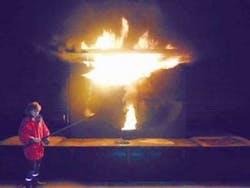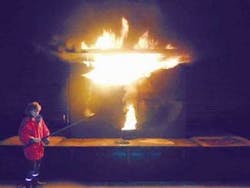New fire control system designed for larger spaces
Jennifer Pallanich Hull
Special Reports Editor
Marioff has launched a new fire pro-tection line to put out fires in large machine spaces. The HI-FOG MT3 system has passed IMO fire tests for Class 3 machinery spaces, and tested in a 3,400-cu-m enclosure to handle unlimited volumes with a ceiling height to 11 m, Marioff said. The company said the innovative application of pressure differences between nozzles ensures efficient distribution of the fog in the machinery area.
null
While HI-FOG MT3 is not yet installed in the offshore industry, said Marioff President Petteri Saarinen, some systems are operating in marine applications. He said the system is especially suited for drillship engine rooms and other locations where the fire load contains gas or burning liquid material.
Using water as the extinguishing agent, HI-FOG MT3 can provide post-fire cooling of the machinery space to prevent re-ignition.
HI-FOG MT3 consists of two piping systems. The main system supplies the water, which is discharged as water mist at the nozzles. Using the sequential water mist supply arrangement improves the mist distribution, ensuring the space is filled, even in large machinery spaces. The secondary piping system distributes a water-nitrogen mixture, extinguishing even the most demanding fires.
The HI-FOG MT3 is an expansion on the company's existing line of products that extinguish fire with water.
"It's basic physics," Saarinen said.
The spray nozzle and high pressure combine to break small water droplets into vapor, which expands in the heat and blocks oxygen locally from reaching and feeding the fire. Marioff, formed in 1991, said it has more than 1,000 patents and patent applications for its processes and products. In its 11 years, the Finnish company has completed more than 5,000 full-scale fire performance tests.
The system combines the extinguishing characteristics of water with penetrative qualities of gases without placing personnel or the environment at a safety risk. The high momentum discharge of small water droplets penetrates and extinguishes all types of fires, the company said. On activation, the system floods the protected space with a high-density mist, absorbs and blocks heat radiation, and prevents oxygen from entering the combustion area.
The company designs and manufactures both open spray heads and closed sprinkler heads with heat-sensitive release glass bulbs.
While HI-FOG components are not less expensive than competitor's components, Saarinen said, the cost of the overall system is less expensive, especially given the speed with which the installation can be completed. He said smaller pipes contribute to the quicker installation pace and a weight savings, and costs to replenish the water used in the system are low.
"We only need a small amount of water," he said.
Because the system uses such a small amount of water, damage from water is minimal, the company said.
Additionally, water, is safe for people and the environment, unlike CO2- or halon-based systems. HI-FOG cools the environment and is available for smoke scrubbing applications, the company said. Finally, most gaseous agents require enclosure integrity before they can extinguish flames, Marioff said. Securing the area can take some time to occur because people must be evacuated from the area and the ventilation must be turned off before the gas is released, allowing more time for the fire to grow. The water-based HI-FOG system can be released immediately, even if people are in the area, to quash a fire in its infancy, the company said.
The systems can be added to newbuilds or as an upgrade to existing vessels.
"Retrofitting can be fast," Saarinen said.
Marioff can retrofit a vessel that is in motion by closing off a section of the vessel at a time. This minimal disruption of the business appeals to vessel operators, he said. In 2003, about 30% of the company's business was in retrofit.
"We've done a few CO2 changeovers already," he said.
Saarinen sees Marioff replacing many halon, carbon dioxide, and reactive gas protection systems in the next five to 10 years. The passenger vessel sector of the marine industry must retrofit vessels with fixed fire protection systems by October 2005. These retrofits will install fire protection in vessels originally built without such devices, such as sprinkler systems in accommodation areas of vessels built before the mid-1990s. Marioff will also install its water-based systems to protect high-risk areas, such as machinery spaces, in certain existing vessels, also by late 2005.
"Water mist is still scratching the surface," he said.
Recent work
Marioff is providing three systems for Shell's Bonga FPSO off Nigeria. Marioff's Finland and Korean arms provided HI-FOG systems to protect seven accommodation and service area decks, oil purifier rooms, fire pump compartments, hydraulic power pack compartments, incinerator and transformer rooms, inert gas generator room, and emergency and essential diesel generator rooms while the unit was at the Samsung shipyard. Marioff's UK operation provided protection for four power generation turbines for Bonga through Amec. The USA arm is handling the compressor turbine protection together with the turbine manufacturer. The last piece of the Bonga work is due for delivery in October.
Marioff also has a ¤5 million order to replace CO2 systems and a ¤2 million order to replace halon systems for operators in the North Sea. The ¤5 million order includes 70 units and should be complete by September, Saarinen said, while the ¤2 million order is for 30 units under a similar time frame.

